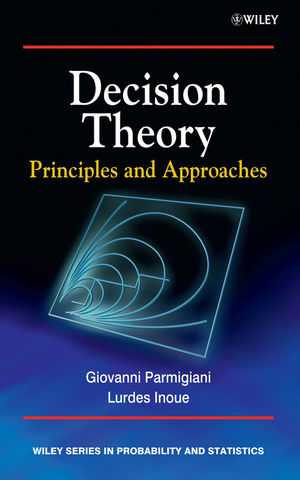Decision Theory: Principles and ApproachesISBN: 978-0-471-49657-1
Hardcover
408 pages
May 2009
 This is a Print-on-Demand title. It will be printed specifically to fill your order. Please allow an additional 15-20 days delivery time. The book is not returnable.
|
||||||
Preface.
Acknowledgments.
1 Introduction.
1.1 Controversies.
1.2 A guided tour of decision theory.
Part One: Foundations.
2 Coherence.
2.1 The "Dutch Book" theorem.
2.2 Temporal coherence.
2.3 Scoring rules and the axioms of probabilities.
2.4 Exercises.
3 Utility.
3.1 St. Petersburg paradox.
3.2 Expected utility theory and the theory of means.
3.3 The expected utility principle.
3.4 The von Neumann-Morgenstern representation theorem.
3.5 Allais' criticism.
3.6 Extensions.
3.7 Exercises.
4 Utility in action.
4.1 The "standard gamble".
4.2 Utility of money.
4.3 Utility functions for medical decisions.
4.4 Exercises.
5 Ramsey and Savage.
5.1 Ramsey's theory.
5.2 Savage's theory.
5.3 Allais revisited.
5.4 Ellsberg paradox.
5.5 Exercises.
6 State independence.
6.1 Horse lotteries.
6.2 State-dependent utilities.
6.3 State-independent utilities.
6.4 Anscombe-Aumann representation theorem.
6.5 Exercises.
Part Two Statistical Decision Theory.
7 Decision functions.
7.1 Basic concepts.
7.2 Data-based decisions.
7.3 The travel insurance example.
7.4 Randomized decision rules.
7.5 Classification and hypothesis tests.
7.6 Estimation.
7.7 Minimax-Bayes connections.
7.8 Exercises.
8 Admissibility.
8.1 Admissibility and completeness.
8.2 Admissibility and minimax.
8.3 Admissibility and Bayes.
8.4 Complete classes.
8.5 Using the same ± level across studies with different sample sizes is inadmissible.
8.6 Exercises.
9 Shrinkage.
9.1 The Stein effect.
9.2 Geometric and empirical Bayes heuristics.
9.3 General shrinkage functions.
9.4 Shrinkage with different likelihood and losses.
9.5 Exercises.
10 Scoring rules.
10.1 Betting and forecasting.
10.2 Scoring rules.
10.3 Local scoring rules.
10.4 Calibration and refinement.
10.5 Exercises.
11 Choosing models.
11.1 The "true model" perspective.
11.2 Model elaborations.
11.3 Exercises.
Part Three Optimal Design.
12 Dynamic programming.
12.1 History.
12.2 The travel insurance example revisited.
12.3 Dynamic programming.
12.4 Trading off immediate gains and information.
12.5 Sequential clinical trials.
12.6 Variable selection in multiple regression.
12.7 Computing.
12.8 Exercises.
13 Changes in utility as information.
13.1 Measuring the value of information.
13.2 Examples.
13.3 Lindley information.
13.4 Minimax and the value of information.
13.5 Exercises.
14 Sample size.
14.1 Decision-theoretic approaches to sample size.
14.2 Computing.
14.3 Examples.
14.4 Exercises.
15 Stopping.
15.1 Historical note.
15.2 A motivating example.
15.3 Bayesian optimal stopping.
15.4 Examples.
15.5 Sequential sampling to reduce uncertainty.
15.6 The stopping rule principle.
15.7 Exercises.
Appendix.
A.1 Notation.
A.2 Relations.
A.3 Probability (density) functions of some distributions.
A.4 Conjugate updating.
References.
Index.
Acknowledgments.
1 Introduction.
1.1 Controversies.
1.2 A guided tour of decision theory.
Part One: Foundations.
2 Coherence.
2.1 The "Dutch Book" theorem.
2.2 Temporal coherence.
2.3 Scoring rules and the axioms of probabilities.
2.4 Exercises.
3 Utility.
3.1 St. Petersburg paradox.
3.2 Expected utility theory and the theory of means.
3.3 The expected utility principle.
3.4 The von Neumann-Morgenstern representation theorem.
3.5 Allais' criticism.
3.6 Extensions.
3.7 Exercises.
4 Utility in action.
4.1 The "standard gamble".
4.2 Utility of money.
4.3 Utility functions for medical decisions.
4.4 Exercises.
5 Ramsey and Savage.
5.1 Ramsey's theory.
5.2 Savage's theory.
5.3 Allais revisited.
5.4 Ellsberg paradox.
5.5 Exercises.
6 State independence.
6.1 Horse lotteries.
6.2 State-dependent utilities.
6.3 State-independent utilities.
6.4 Anscombe-Aumann representation theorem.
6.5 Exercises.
Part Two Statistical Decision Theory.
7 Decision functions.
7.1 Basic concepts.
7.2 Data-based decisions.
7.3 The travel insurance example.
7.4 Randomized decision rules.
7.5 Classification and hypothesis tests.
7.6 Estimation.
7.7 Minimax-Bayes connections.
7.8 Exercises.
8 Admissibility.
8.1 Admissibility and completeness.
8.2 Admissibility and minimax.
8.3 Admissibility and Bayes.
8.4 Complete classes.
8.5 Using the same ± level across studies with different sample sizes is inadmissible.
8.6 Exercises.
9 Shrinkage.
9.1 The Stein effect.
9.2 Geometric and empirical Bayes heuristics.
9.3 General shrinkage functions.
9.4 Shrinkage with different likelihood and losses.
9.5 Exercises.
10 Scoring rules.
10.1 Betting and forecasting.
10.2 Scoring rules.
10.3 Local scoring rules.
10.4 Calibration and refinement.
10.5 Exercises.
11 Choosing models.
11.1 The "true model" perspective.
11.2 Model elaborations.
11.3 Exercises.
Part Three Optimal Design.
12 Dynamic programming.
12.1 History.
12.2 The travel insurance example revisited.
12.3 Dynamic programming.
12.4 Trading off immediate gains and information.
12.5 Sequential clinical trials.
12.6 Variable selection in multiple regression.
12.7 Computing.
12.8 Exercises.
13 Changes in utility as information.
13.1 Measuring the value of information.
13.2 Examples.
13.3 Lindley information.
13.4 Minimax and the value of information.
13.5 Exercises.
14 Sample size.
14.1 Decision-theoretic approaches to sample size.
14.2 Computing.
14.3 Examples.
14.4 Exercises.
15 Stopping.
15.1 Historical note.
15.2 A motivating example.
15.3 Bayesian optimal stopping.
15.4 Examples.
15.5 Sequential sampling to reduce uncertainty.
15.6 The stopping rule principle.
15.7 Exercises.
Appendix.
A.1 Notation.
A.2 Relations.
A.3 Probability (density) functions of some distributions.
A.4 Conjugate updating.
References.
Index.



